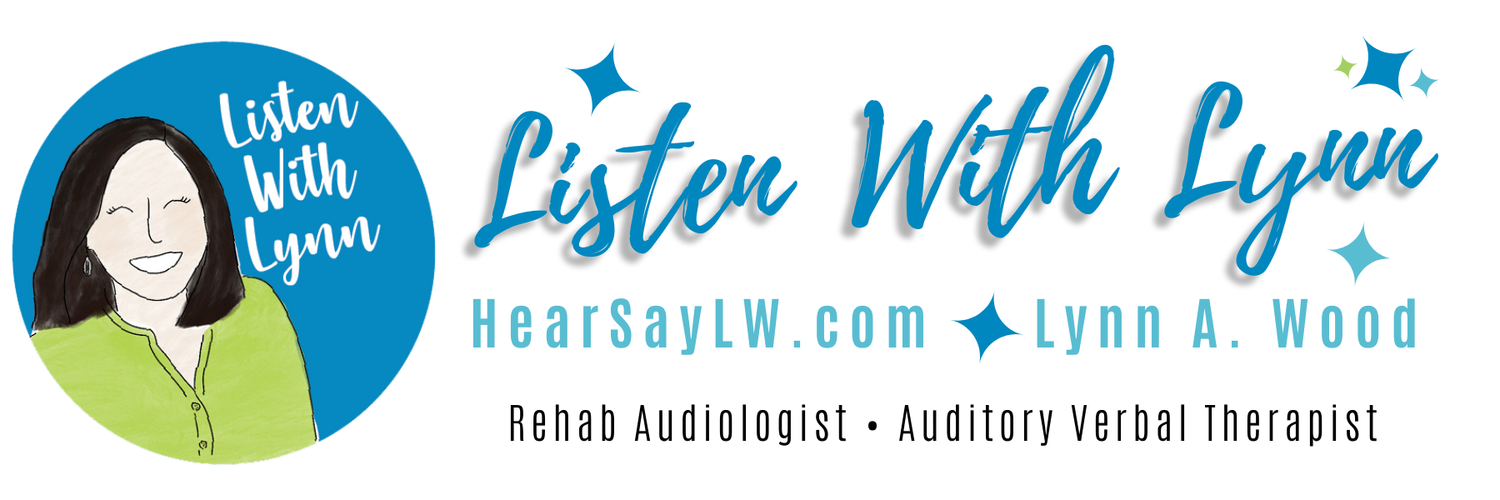Leaf Rubbings are one of my favorite fall auditory verbal activities. This activity encourages the children to listen and observe as we discuss the wonders of nature with supporting vocabulary within a rich LSL conversation.
Materials/Advance Preparation:
fresh leaves of different shapes and sizes
crayons, preferably thick ones with the paper stripped off
thin copy paper.
fresh leaves of different shapes and sizes
crayons, preferably thick ones with the paper stripped off
thin copy paper.
Directions:
1. Place a leaf view side up on a smooth table and cover with a sheet of paper.
2. Using the side of the crayon (lay the crayon down on the paper), rub the crayon back and forth until the leaf's outline and features are clearly visible.
3. Place another leaf under the paper and use a different colored crayon to make a rubbing.It's fine if the leaf rubbings overlap a bit; in fact, it makes the rubbing even more beautiful.
4. Together notice and describe features of the rubbings (e.g. "My leaf has three points," “The yellow leaf has a jaggedy edge").
1. Place a leaf view side up on a smooth table and cover with a sheet of paper.
2. Using the side of the crayon (lay the crayon down on the paper), rub the crayon back and forth until the leaf's outline and features are clearly visible.
3. Place another leaf under the paper and use a different colored crayon to make a rubbing.It's fine if the leaf rubbings overlap a bit; in fact, it makes the rubbing even more beautiful.
4. Together notice and describe features of the rubbings (e.g. "My leaf has three points," “The yellow leaf has a jaggedy edge").
Adjectives:
-Color words - green, red, orange, yellow, brown…. golden, crimson
-Dry, crunchy, rustling, noisy
-Rough, smooth, pretty, rounded, pointed, jagged edges
-Color words - green, red, orange, yellow, brown…. golden, crimson
-Dry, crunchy, rustling, noisy
-Rough, smooth, pretty, rounded, pointed, jagged edges
Home Carryover Suggestions:
I encourage the parents to take their child on a leaf walk to collect leaves for this activity at home. I remind them that while they are raking and playing in the leaves to talk about what you are doing and what you see and the more times your child hears these words, the more likely he/she is to retain and learn them.
Nouns:
-Leaf
-Rake
-Bag
-Tree
-Branch
-Acorn
-Squirrel
-Bird
-Stick
-Pile
I encourage the parents to take their child on a leaf walk to collect leaves for this activity at home. I remind them that while they are raking and playing in the leaves to talk about what you are doing and what you see and the more times your child hears these words, the more likely he/she is to retain and learn them.
Nouns:
-Leaf
-Rake
-Bag
-Tree
-Branch
-Acorn
-Squirrel
-Bird
-Stick
-Pile
Verbs:
-Rake
-Jump
-Throw
-Drop
-Climb
A fun way to work on verbs is by making a pile of leaves and then practicing different actions through the piles. For example, the child can march, stomp, skip, run, or roll through the pile. Take pictures as a way to expand LSL once the activity is over.
-Rake
-Jump
-Throw
-Drop
-Climb
A fun way to work on verbs is by making a pile of leaves and then practicing different actions through the piles. For example, the child can march, stomp, skip, run, or roll through the pile. Take pictures as a way to expand LSL once the activity is over.
Follow-Up Leaf Craft - Following Directions/Sequencing
Set the activity up so that there are steps the child has to complete. Think about what would help your child do this activity easily, and then make it just a little bit harder. For example, if you think “my child could listen and follow one step of this at a time easily”, then give them two directions at a time. Here are the steps to the activity that you can use to create the directions for your child. Remember to present through hearing first!
Set the activity up so that there are steps the child has to complete. Think about what would help your child do this activity easily, and then make it just a little bit harder. For example, if you think “my child could listen and follow one step of this at a time easily”, then give them two directions at a time. Here are the steps to the activity that you can use to create the directions for your child. Remember to present through hearing first!
1. Collect leaves
2. Draw a picture on paper of a bare tree, a pumpkin patch…. (for younger children, skip this step)
3. Spread glue on paper
4. Put leaves on glue
5. Place your picture in a safe place to dry
2. Draw a picture on paper of a bare tree, a pumpkin patch…. (for younger children, skip this step)
3. Spread glue on paper
4. Put leaves on glue
5. Place your picture in a safe place to dry
After you’re done, go back and talk about the activity with your child. You can talk about what you did first, next, and last. Have your child share the leaf craft and tell someone else about the what s/he created with the leaves.










